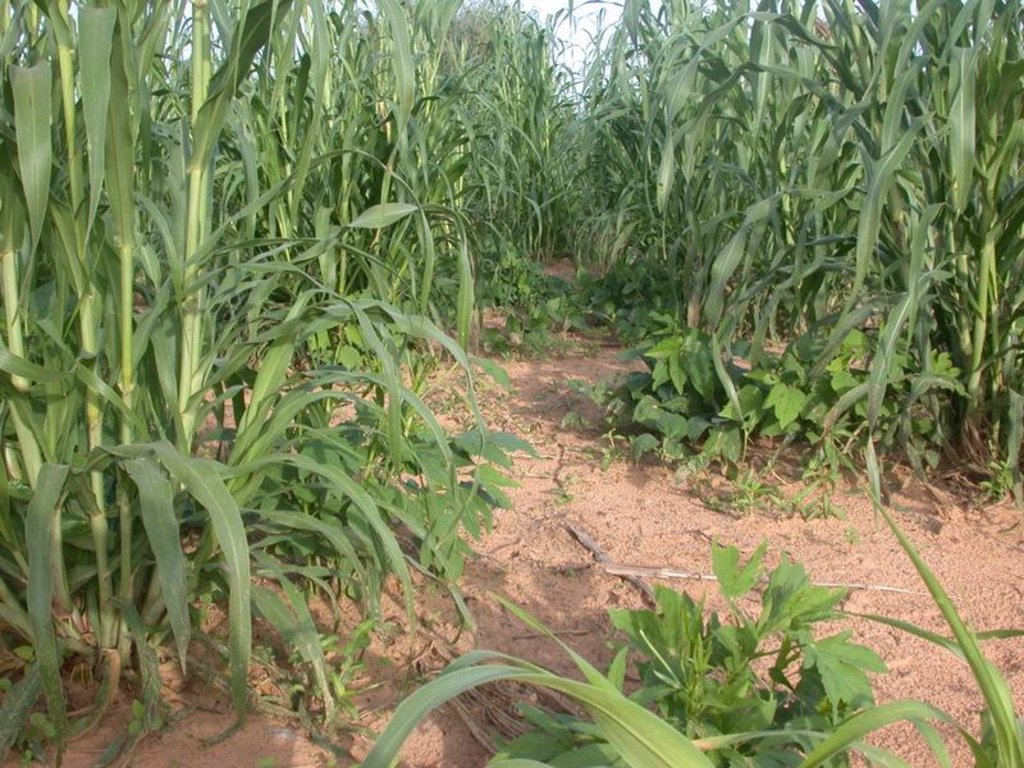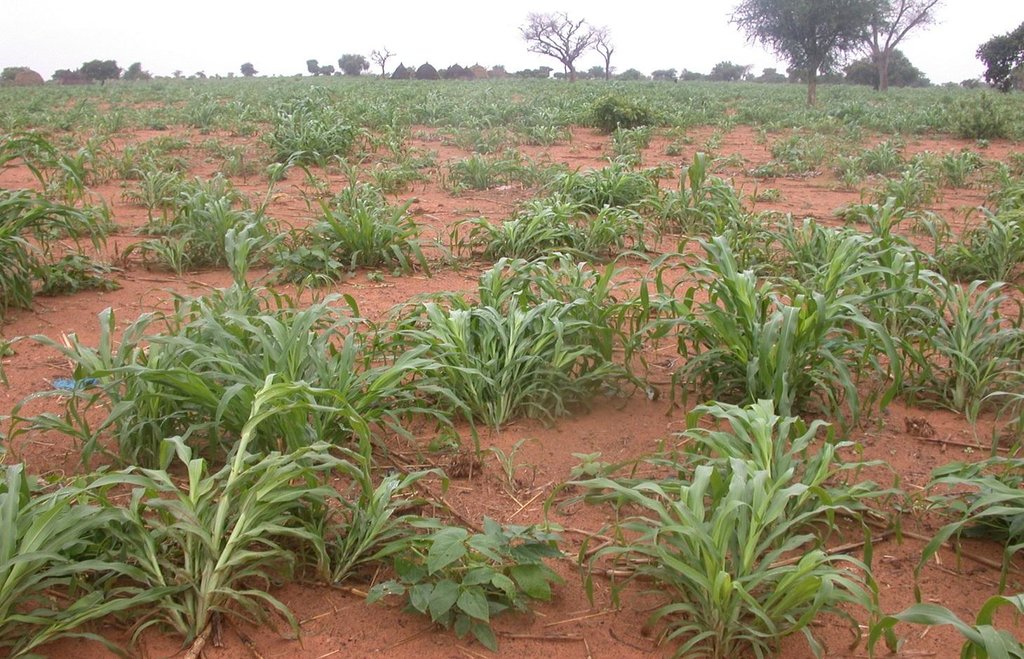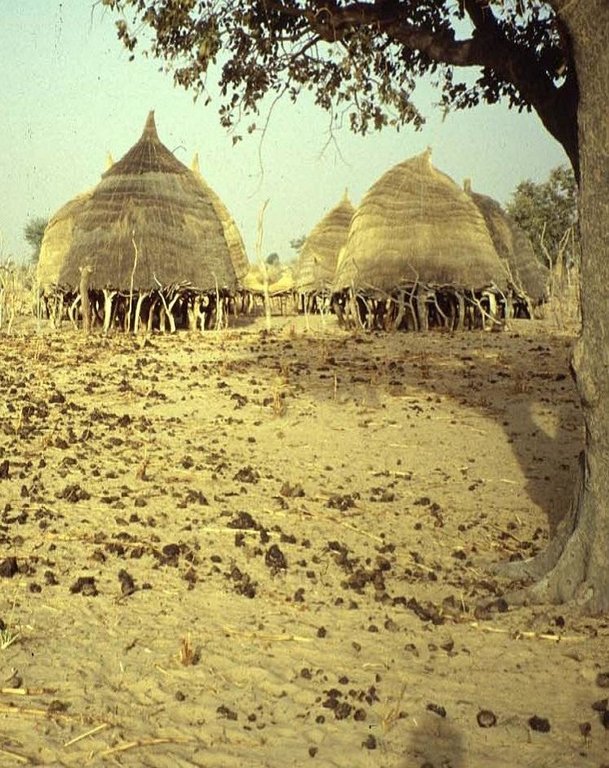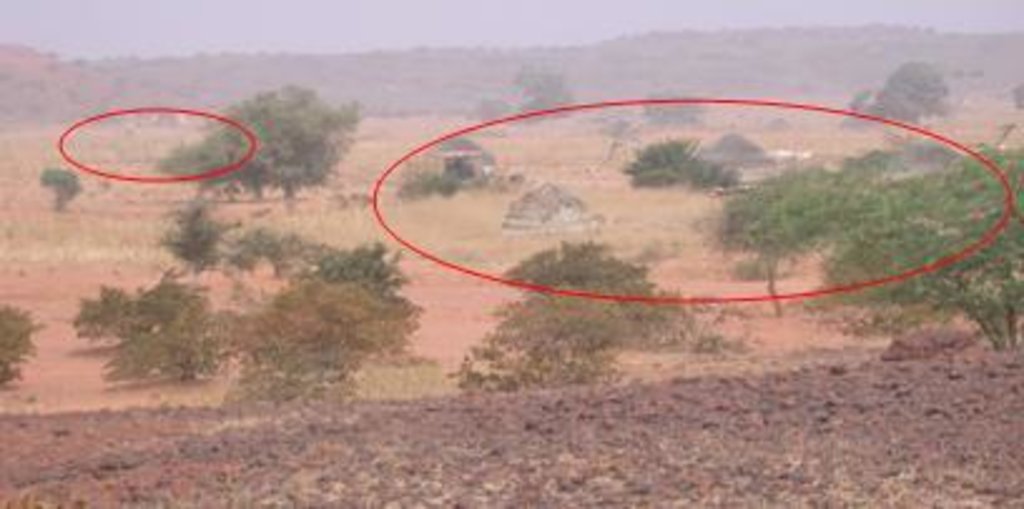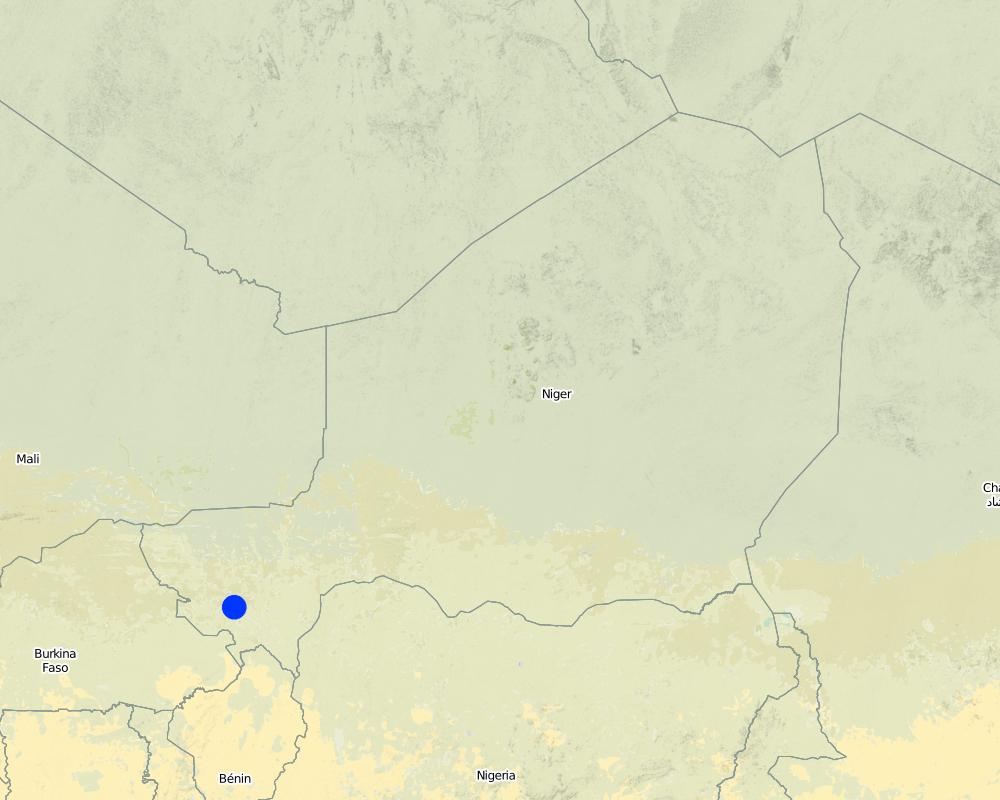Rotational Fertilization [النيجر]
- تاريخ الإنشاء:
- تحديث:
- جامع المعلومات: Julie Zähringer
- المحرر: –
- المُراجع: Alexandra Gavilano
technologies_953 - النيجر
عرض الأقسام
توسيع الكل طي الكل1. معلومات عامة
1.3 الشروط المتعلقة باستخدام البيانات الموثقة من خلال WOCAT
يوافق جامع المعلومات والشخص (لاشخاص) الرئيسي لمصدر المعلومات على الشروط المتعلقة باستخدام البيانات الموثقة من خلال WOCAT:
نعم
2. وصف تقنيةالإدارة المستدامي للأراضي
2.1 وصف مختصر للتقنية
تعريف التقنية:
Rotational fertilization is an integrated crop-livestock management measure practiced by the agropastoralist Peulh.
2.2 وصف تفصيلي للتقنية
الوصف:
At intervals of 2-3 years the Peulh agropastoralists relocate with their livestock to a new area previously used for crop cultivation - where they install their temporary dwellings and improve soil fertility by applying farmyard manure and other organic materials.
The rotation of temporary habitation areas leads to successive fertilization of the land. Livestock (cattle or small ruminants) are corralled or tethered in the rehabilitation area over-night. They feed on crop residues and emerging grasses after harvesting of the crops. Dung dropped within the coral area is collected and then distributed on the fields. The main criterion for site selection is the level of land degradation. The size of the area occupied is maximum 500 m2, and depends on family size, herd size and on the quantitative and qualitative objectives of soil fertilization of the land owner.
In the years after settlement (after families move to a new location) the treated area is used for crop cultivation, and crop rotation/intercropping are practiced (e.g. millet/ legumes) for increased and diversified production, improved pest control and fertility management.
The effectiveness of this technology has led to field-fertilization contracts between agro-pastoralists and sedentary farmers. The farmers offer post-harvest grazing rights to the agropastoralists who in turn fertilize the land and benefit from the access to the important weekly markets in the area where they can sell milk. In this case the agropastoralist families and their livestock split up after the rainy season: a part assures fertilization of the own land, the other part is in charge of fertilizing foreign land (during 3-4 months) before returning home.
2.3 صور التقنية
2.5 البلد/المنطقة/المواقع التي تم تنفيذ التقنية فيها والتي يغطيها هذا التقييم
البلد:
النيجر
المنطقة/الولاية/المحافظة:
Damari, Kollo District
مزيد من التفاصيل حول الموقع:
Tillabéry Region, Niger
Map
×2.6 تاريخ التنفيذ
في حالة عدم معرفة السنة بالتحديد، يرجى الإشارة إلى التاريخ التقريبي:
- منذ أكثر من 50 عامًا (تقليدي)
2.7 إدخال التقنية
حدد كيف تم إدخال التقنية:
- كجزء من النظام التقليدي (> 50 عامًا)
3. تصنيف تقنية الإدارة المستدامي للأراضي
3.2 نوع (أنواع) استخدام الأراضي الحالية حيث يتم تطبيق التقنية

المستوطنات والبنية التحتية

الأراضي الزراعية
- زراعة سنوية
التعليقات:
Major land use problems (land users’ perception): Soil fertility decline, soil erosion by wind and water
Semi-nomadism / pastoralism: Yes
Livestock is grazing on crop residues
3.3 مزيد من المعلومات حول استخدام الأراضي
التعليقات:
Water supply: rainfed, rainfed
3.5 انتشار التقنية
التعليقات:
Total area covered by the SLM Technology is 1500 m2.
3.6 التدابير التقنية في مجال إلادارة المستدامة للأراضي

التدابير الإدارية
- M1: التغيير في نوع استخدام الأراضي

التدابير الزراعية
- A2: المادة العضوية/خصوبة التربة
التعليقات:
Main measures: agronomic measures, management measures
Type of agronomic measures: manure / compost / residues
3.7 الأنواع الرئيسية من تدهور الأراضي التي تناولتها التقنية

تآكل التربة الناتج عن الرياح
- (Et): فقدان التربة السطحية

تآكل التربة بالمياه
- الوزن(Wt): فقدان التربة السطحية/تآكل السطح

التدهور الكيميائي للتربة
- (Cn): تراجع الخصوبة وانخفاض محتوى المادة العضوية (غير ناتج عن الانجراف)
التعليقات:
Main type of degradation addressed: Wt: loss of topsoil / surface erosion, Et: loss of topsoil, Cn: fertility decline and reduced organic matter content
3.8 منع أو حد أو عكس تدهور الأراضي
تحديد هدف التقنية فيما يتعلق بتدهور الأراضي:
- اصلاح/إعادة تأهيل الأراضي المتدهورة بشدة
التعليقات:
Main goals: rehabilitation / reclamation of denuded land
4. المواصفات الفنية، وأنشطة التنفيذ، والمدخلات، والتكاليف
4.2 المواصفات الفنية/شروحات الرسم الفني
Technical knowledge required for field staff / advisors: (not applicable)
Technical knowledge required for land users: low
Main technical functions: increase in organic matter, increase in nutrient availability (supply, recycling,…)
Manure / compost / residues
Material/ species: farmyard manure and other organic materials
4.6 الصيانة/الأنشطة المتكررة
| النشاط | نوع التدبير | التوقيت/الوتيرة | |
|---|---|---|---|
| 1. | On land being treated: on-going fertilisation by applying farmyard manure and any kind of organic material accruing from daily human activities to the soil during 2-3 years | زراعية | during 2-3 years |
| 2. | On land being treated: on-going fertilisation by applying farmyard manure and any kind of organic material accruing from daily human activities to the soil during 2-3 years | زراعية | during 2-3 years |
| 3. | On land being treated: on-going fertilisation by applying farmyard manure and any kind of organic material accruing from daily human activities to the soil during 2-3 years | زراعية | during 2-3 years |
| 4. | On land being treated: on-going fertilisation by applying farmyard manure and any kind of organic material accruing from daily human activities to the soil during 2-3 years | زراعية | during 2-3 years |
| 5. | On land being treated: on-going fertilisation by applying farmyard manure and any kind of organic material accruing from daily human activities to the soil during 2-3 years | زراعية | during 2-3 years |
| 6. | Maintenance/ re-location of huts to improve fertilization of land (after rainy season). | زراعية | |
| 7. | On previously treated land: Land preparation (ploughing, e.g. cowpea). | زراعية | |
| 8. | Cultivation of millet and legumes ('niébé') as intercrop or in the form of crop rotation. | زراعية |
4.8 أهم العوامل المؤثرة على التكاليف
قدم وصفا لأهم العوامل التي تؤثر على التكاليف:
Establishment of housing infrastructure is done collectively, involving dozens of community members within less than a week. Construction material is taken from the woodlands; many parts are re-used after moving. While expenses are expressed in US$, in reality costs are in kind (mutual help) or not paid for (free lumber). Maintenance activities include: maintenance and re-building of dwellings. Costs for crop cultivation (US$ 335-535 annually) are not included.
5. البيئة الطبيعية والبشرية
5.1 المناخ
هطول الأمطار السنوي
- < 250 مم
- 251- 500 ملم
- 501 - 750ملم
- 1,000-751 ملم
- 1,500-1,100 ملم
- 2,000-1,500 ملم
- 3,000-2,001 ملم
- 4,000-3,100 ملم
- > 4000 ملم
المنطقة المناخية الزراعية
- شبه قاحلة
Thermal climate class: tropics
5.2 طوبوغرافيا
متوسط الانحدارات:
- مسطح (0-2%)
- بسيط (3-5%)
- معتدل (6-10%)
- متدحرج (11-15%)
- تلال (16-30%)
- شديدة الانحدار(31-60%)
- فائقة الانحدار (>60%)
التضاريس:
- هضاب/سهول
- أثلام مرتفعة
- المنحدرات الجبلية
- منحدرات التلال
- منحدرات في السفوح
- قاع الوادي
المنطقة الارتفاعية:
- 100-0 متر فوق سطح البحر
- 500-101 متر فوق سطح البحر
- 1,000-501 متر فوق سطح البحر
- 1,500-1,001 متر فوق سطح البحر
- 2,000-1,501 متر فوق سطح البحر
- 2,500-2,100 متر فوق سطح البحر
- 3,000-2,501 متر فوق سطح البحر
- 4,000-3,001 متر فوق سطح البحر
- > 4000 متر فوق سطح البحر
5.3 التربة
متوسط عمق التربة:
- ضحل جدًا (0-20 سم)
- ضحلة (21-50 سم)
- متوسطة العمق (51-80 سم)
- عميقة (81-120 سم)
- عميقة جدًا (> 120 سم)
قوام التربة (التربة السطحية):
- خشن / خفيف (رملي)
المواد العضوية في التربة السطحية:
- منخفضة (<1%)
5.6 خصائص مستخدمي الأراضي الذين يطبقون التقنية
المستوى النسبي للثروة:
- ضعيف
أفراداً أو مجموعات:
- المجموعات/ المجتمع المحلي
مستوى المكننة:
- عمل يدوي
اذكر الخصائص الأخرى ذات الصلة لمستخدمي الأراضي:
Land users applying the Technology are mainly disadvantaged land users
Population density: 10-50 persons/km2
(100).
Market orientation of production system: subsistence (self-supply), subsistence (self-supply), mixed (subsistence/ commercial
5.7 متوسط مساحة الأرض المملوكة أو المستأجرة من قبل مستخدمي الأراضي الذين يطبقون التقنية
- < 0.5 هكتارا
- 0.5 - 1 هكتار
- 1 -2 هكتار
- 2 - 5 هكتار
- 5 - 15 هكتار
- 15 - 50 هكتار
- 50 - 100هكتار
- 500-100 هكتار
- 1,000-500 هكتار
- 10,000-1,000 هكتار
- > 10,000 هكتار
هل يعتبر هذا نطاقًا صغيرًا أو متوسطًا أو واسعا (في إشارة إلى السياق المحلي)؟:
- على نطاق صغير
5.8 ملكية الأراضي، وحقوق استخدام الأراضي، وحقوق استخدام المياه
ملكية الارض:
- فردية، لا يوجد سند ملكية
حقوق استخدام الأراضي:
- فردي
- مجتمعي (منظم)
التعليقات:
Land use rights: individual, communal (organized)
6. الآثار والتصريحات الختامية
6.1 الآثار التي أظهرتها التقنية في الموقع
الآثار الاجتماعية والاقتصادية
الإنتاج
إنتاج المحاصيل
إنتاج الأعلاف
جودة العلف
إنتاج حيواني
الدخل والتكاليف
دخل المزرعة
الآثار الاجتماعية والثقافية
الفرص الثقافية
المؤسسات المجتمعية
التخفيف من حدة الصراع
الآثار الايكولوجية
التربة
غطاء التربة
فقدان التربة
المادة العضوية في التربة/تحت الطبقة c
التنوع البيولوجي: الغطاء النباتي، الحيوانات
الكتلة الحيوية/ طبقة الكربون فوق التربة
التنوع الحيواني
الحد من مخاطر المناخ والكوارث
سرعة الرياح
6.2 الآثار التي أظهرتها التقنية خارج الموقع
الرواسب المنقولة بواسطة الرياح
الأضرار التي لحقت بحقول الجيران
الضرر على البنية التحتية العامة/ الخاصة
6.3 تعرض التقنية وحساسيتها لتغير المناخ التدريجي والظواهر المتطرفة/الكوارث المرتبطة بالمناخ (كما يراها مستخدمو الأراضي)
تغير مناخ تدريجي
تغير مناخ تدريجي
| الموسم | نوع التغير المناخي/ المتطرف | كيف تتعامل التقنية مع ذلك؟ | |
|---|---|---|---|
| درجة الحرارة السنوية | زيادة | جيدا |
الظواهر المتطرفة / الكوارث المرتبطة بالمناخ
الكوارث الجوية
| كيف تتعامل التقنية مع ذلك؟ | |
|---|---|
| عاصفة ممطرة محلية | ليس جيدا |
| عاصفة هوائية محلية | ليس جيدا |
الكوارث المناخية
| كيف تتعامل التقنية مع ذلك؟ | |
|---|---|
| جفاف | ليس جيدا |
الكوارث الهيدرولوجية
| كيف تتعامل التقنية مع ذلك؟ | |
|---|---|
| فيضان عام (نهر) | ليس جيدا |
العواقب الأخرى المتعلقة بالمناخ
العواقب الأخرى المتعلقة بالمناخ
| كيف تتعامل التقنية مع ذلك؟ | |
|---|---|
| انخفاض فترة النمو | جيدا |
6.4 تحليل التكلفة والعائد
كيف يمكن مقارنة العوائد نسبة لتكاليف الإنشاء (من وجهة نظر مستخدمي الأراضي)؟
عوائد قصيرة الأجل:
إيجابي
عوائد طويلة الأجل:
ايجابي جدا
كيف تتم مقارنة العوائدمع كلفة الصيانة/التكاليف المتكررة (من وجهة نظر مستخدمي الأراضي)؟
عوائد قصيرة الأجل:
إيجابي
عوائد طويلة الأجل:
ايجابي جدا
التعليقات:
The impact of the measure on soil productivity is increasing in the mid and long term
6.5 اعتماد التقنية
التعليقات:
There is a strong trend towards spontaneous adoption of the Technology
Comments on adoption trend: Its high effectiveness has helped spread the technology to adjacent areas on the other side of the river Niger, where farmers contract the agropastoralists for their ‘fertilization service’. The area covered by the technology is approximately 1'500 km2.
6.8 نقاط ضعف / مساوىء / مخاطر التقنية وسبل التغلب عليها
| نقاط الضعف/ المساوىء/ المخاطر من وجهة نظر جامع المعلومات أو غيره من الاشخاص الرئيسيين لمصدر المعلومات | كيف يمكن التغلب عليها؟ |
|---|---|
| Growing costs and decreasing availability of timber and poles for establishment of infrastructure | re-introduce traditional techniques of long-term conservation of housing materials. |
| High labour input for implementation | reinforce community structures for mutual help. |
| Area treated by the technology is too small regarding the area in need of treatment (degraded land) | reinforce the solidarity between communities to increase the treated area. |
| Negative effect on the woodland (brousse tigrée): cutting for building materials, clearing for cultivation | identify new ecological materials for house construction; tree plantation. |
| Marginalization of families with low activity potential | reinforce mutual help systems to support poor / small families. |
7. المراجع والروابط
7.2 المراجع للمنشورات المتاحة
العنوان، المؤلف، السنة، النظام القياسي الدولي لترقيم الكتب ISBN:
Caroline Dandois Dutordoir (2006): Impact de pratiques de gestion de la fertilité sur les rendements en mil dans le Fakara (Niger), Université catholique de Louvain, 2006
العنوان، المؤلف، السنة، النظام القياسي الدولي لترقيم الكتب ISBN:
Bationo, A., Ntare, B. R. 2000 : Rotation and nitrogen fertilizer effects on pearl millet, cowpea and groundnut yield and soil chemical properties in a sandy soil in the semiarid tropics, West Africa. Journal of Agricultural Science, 134, p. 277-284.
متاح من أين؟كم التكلفة؟:
Journal of Agricultural Science, 134, p. 277-284.
العنوان، المؤلف، السنة، النظام القياسي الدولي لترقيم الكتب ISBN:
Ministère du développement agricole (2005): recueil des fiches techniques en gestion des ressources naturelles et de productions agro-sylvo-pastorales.
الروابط والوحدات المواضيعية
توسيع الكل طي الكلالروابط
لا يوجد روابط
الوحدات المواضيعية
لا يوجد وحدات مواضيعية



